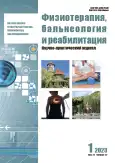The use of aromatherapy in pediatric practice
- Authors: Chervinskaya A.V.1, Khan M.A.2,3, Korchazhkina N.B.4, Lyan N.A.3,5, Mikitchenko N.A.3
-
Affiliations:
- Central State Medical Academy of Department of Presidential Affairs
- Filatov N.F. Children's City Hospital, Moscow
- Moscow Centre for Research and Practice in Medical Rehabilitation, Restorative and Sports Medicine
- Petrovsky National Research Centre of Surgery
- The First Sechenov Moscow State Medical University (Sechenov University)
- Issue: Vol 22, No 1 (2023)
- Pages: 63-69
- Section: Review
- URL: https://journals.rcsi.science/1681-3456/article/view/249474
- DOI: https://doi.org/10.17816/rjpbr119538
- ID: 249474
Cite item
Abstract
Aromatherapy is a method of treatment using natural essential oils injected into the body through the respiratory tract, skin and (or) mucous membranes. Currently, about 3,000 essential oil plants have been studied, from which over 500 organic compounds have been isolated and identified, the number of which in the composition of one essential oil can vary from 120 to 500, and no essential oil has yet been fully investigated.
Essential oils are multicomponent organic compounds of terpenes, alcohols, aldehydes, ketones and other hydrocarbons produced by essential oil plants. Biologically active substances of essential oils have a low molecular weight and therefore easily penetrate the skin through the bloodstream. The effect exerted on a person by essential oils is determined in two ways ― neuro-reflex and humoral. Each essential oil is multifunctional. The composition of essential oils can include up to 300 components, so they can have several medicinal properties at the same time, but there is a general trend in the action of essential oils. All of them have immunomodulatory, pronounced bactericidal and antiseptic effects, antiviral and anti-inflammatory properties.
In medical practice, the method of hardware aromatherapy is used, the active factor of which is a therapeutic respiratory environment that simulates the natural air background over plants. The study of the effect of essential oils in children's institutions showed their positive effect on the general condition of children, emotional tone, immunological reactivity and nonspecific protection factors, the frequency and severity of respiratory pathology, the course of the adaptation period. The beneficial effect of the complex effect of aromatherapy in the sensory room is shown.
Thus, the high efficiency of hardware aromatherapy, good tolerability, the availability of domestic equipment allows us to recommend the method for wide use in therapeutic and preventive and sanatorium-resort institutions.
Full Text
##article.viewOnOriginalSite##About the authors
Alina V. Chervinskaya
Central State Medical Academy of Department of Presidential Affairs
Author for correspondence.
Email: alina.chervinskaya@gmail.com
ORCID iD: 0000-0001-7185-8555
SPIN-code: 4801-7898
MD, Dr. Sci. (Med.), Professor
Russian Federation, 19/1A Marshal Timoshenko street, 121359 MoscowMaya A. Khan
Filatov N.F. Children's City Hospital, Moscow; Moscow Centre for Research and Practice in Medical Rehabilitation, Restorative and Sports Medicine
Email: 6057016@mail.ru
ORCID iD: 0000-0002-1081-1726
SPIN-code: 1070-2800
MD, Dr. Sci. (Med.), Professor
Russian Federation, Moscow; MoscowNatalya B. Korchazhkina
Petrovsky National Research Centre of Surgery
Email: n9857678103@gmail.com
ORCID iD: 0000-0002-9804-7725
SPIN-code: 9733-7646
MD, Dr. Sci. (Med.), Professor
Russian Federation, MoscowNatalia A. Lyan
Moscow Centre for Research and Practice in Medical Rehabilitation, Restorative and Sports Medicine; The First Sechenov Moscow State Medical University (Sechenov University)
Email: nlyan@yandex.ru
ORCID iD: 0000-0003-1566-2739
SPIN-code: 5391-7523
MD, Cand. Sci. (Med.), Leading Researcher
Russian Federation, Moscow; MoscowNatalia A. Mikitchenko
Moscow Centre for Research and Practice in Medical Rehabilitation, Restorative and Sports Medicine
Email: mikitchenko_nata@mail.ru
ORCID iD: 0000-0002-9886-3810
SPIN-code: 6353-9780
MD, Cand. Sci. (Med.), Senior Research Associate
Russian Federation, MoscowReferences
- Kotenko KV, Khan MA, Korchazhkina NB, et al. Modern non-drug technologies of medical rehabilitation of children. Moscow: GEOTAR-Media, 2022. Р. 229–242. (In Russ).
- Chervinskaya AV. Aromafitotherapy. Physiotherapist. 2009;(3):42–47. (In Russ).
- Litvinova T. Aromatherapy: Professional guidance in the world of smells. Rostov-on-Don: Feniks; 2003. 416 p. (In Russ).
- Khan MA, Chervinskaya AV, Vakhova EL, et al. Application of hardware aromatherapy in medical practice. Modern Medical Technologies. 2010;(5):31–33. (In Russ).
- Chervinskaya AV. Modern technologies of respiratory health improvement in resort medicine. Physiotherapist. 2008;(8):62–63. (In Russ).
- Vakhova EL, Mikitchenko NA, Ivanova DA, et al. Modern technologies in the rehabilitation of frequently ill children. Bulletin Restorative Med. 2014;(4):47–56. (In Russ).
- Chervinskaya AV. Health-improving technologies in children's medical and preventive and educational institutions. Spa Vedomosti. 2008;(2):58–59. (In Russ).
- Khan MA. Diseases of children and adolescents. Diseases of the respiratory system. In: Physiotherapy: National Guidelines. Ed. by G.N. Ponomarenko. Moscow: GEOTAR-Media; 2009. Р. 726–731. (In Russ).
- Khan MA, Razumov AN, Korchazhkina NB, et al. Physical and rehabilitation medicine in pediatrics. Moscow: GEOTAR-Media; 2018. 408 p. (In Russ).
Supplementary files






